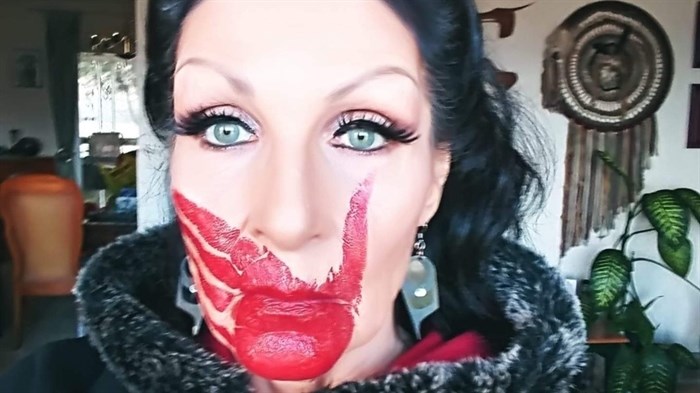
Kim Coltman. The red hand represents missing and murdered Indigenous women and girls. It depicts the inability of MMIWG2S to speak for themselves.
Image Credit: SUBMITTED/Kim Coltman
June 02, 2021 - 6:30 AM
Kim Coltman has spent her life supporting Indigenous women through fashion and modelling.
The Metis entrepreneur from Kamloops took her years of experience in the fashion industry and education in social work to create Fashion Speaks International. The company is geared to support families and communities affected by the trauma of losing a loved one.
In the wake of the recent discovery on the residential school grounds in Kamloops, Coltman is calling for government accountability and encouraging her First Nations relations to share their stories. Stories, she says, have been ignored.
“We have been telling the stories of the atrocities that were perpetrated by the church and the Canadian government for decades,” Coltman said. “Unfortunately no one wanted to hear them. Survivors were once again dehumanized, disrespected and discarded by those who were supposed to 'serve and protect', which is the church and government. Survivors were accused of being delusional, liars, drunks and derelicts. Their tears during the telling fell on deaf ears and cold hearts. They were shamed into silence.”
Coltman feels it is time for the stories to be shared. She says she is horrified that such a tragedy was needed in order for First Nations communities to be heard.
“At this moment in time we have a platform,” Coltman said. “A platform created by the discovery of 215 bodies of little children, in an unmarked mass grave. A discovery that is undeniable proof of what survivors and Elders have told us. It makes me feel sick to my stomach that our platform is literally on the backs of babies. The only light in this darkness is that a spotlight has been shone on the truth and the survivors and Elders are vindicated. The only victory is that those babies can finally go home.”
For Coltman, the recent tragic discovery means the beginning of a lot of work, starting with holding the church and government responsible.
“They must dispatch resources to Kamloops to exhume and identify these children,” Coltman said of the Canadian government. “They must also do the same for every residential school site in Canada. They must respectfully request that all Indigenous peoples who have family members missing from the residential schools provide blood samples so we can trace the children to their families. They must provide funding for the healing process. They must take responsibility for their complete and total failure to honor Treaties and their inhumane treatment of Indigenous peoples.”
Like so many, Coltman has her own story she feels was unheard and ignored.
“I took an Elder directly to the RCMP in Mission (in 1994) where he gave a statement about where the bodies of the dead children of St. Mary's are buried,” Coltman said. “The Elder told them of his role as a gravedigger. He told them about how the older boys were forced to bury the bodies. He told them he was nine years old the first time they forced him to do it. They withheld food and water for non-compliance and made them strip naked in front of the student body if they tried to refuse.
This Elder told the RCMP he would draw them a map but that he could not go there because he could still hear the children screaming and crying. They never even looked, stating that the church would not allow them to. St. Mary's was still open and operational at this time. Even after it shut down in 1996, no one looked. The RCMP blew the Elder off as a delusional drunk and threw the map away. The Elder went into a tailspin and I never saw him again.”
Coltman says she took the Elder’s story to the City of Mission, the local MLA, MP, and press and none of them were interested. She then went to Dr. Hedy Fry, Joy MacPhail and Jean Chretien and she says they too had no interest.
“So I went to the Archdiocese, the bishop and I even tried the monastery in Mission,” Coltman said. “They all said they looked into it and the claims were unfounded. They swept it under the carpet.”
Kim Coltman is well known in Kamloops and is currently working with her community to call the Canadian government to action and to encourage others to share their stories. She continues to work with young Indigenous women in the modelling industry to build their confidence at Fashion Speaks International. She has diplomas in social services and youth work as well as certificates in suicide prevention and intervention, alcohol and drug abuse counselling and rape relief counselling.
“Traditionally, First Nations people do not make eye contact unless they are being challenged or are in an intimate relationship. Because of this, many walk with their heads down and looking at their feet. This is also something that they were taught to do in residential schools. I have been teaching my modelling students to walk with their heads up and to make eye contact. To make themselves visible.”
If you find yourself in need of support please contact one of these organizations:
Indian Residential School Survivors: 1-800-721-0066
KUU-US Indigenous crisis line - available 24 hours
Youth Line: 250-723-2040
Adult Line: 250-723-4050
Residential School Crisis line - available 24 hours: 1-866-925-4419
We welcome your comments and opinions on our stories but play nice. We won't censor or delete comments unless they contain off-topic statements or links, unnecessary vulgarity, false facts, spam or obviously fake profiles. If you have any concerns about what you see in comments, email the editor in the link above.
News from © iNFOnews, 2021